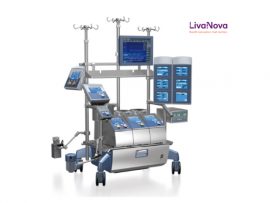Abstract Introduction Bleeding and thrombotic events (BTE) are frequent during extracorporeal membrane oxygenation (ECMO). They occur at varying timepoints and may be affected by temporal changes in coagulation and fibrinolysis...
WeiterlesenAbstract Objective To evaluate the impact of inflammation on monitoring for patients supported with (ECMO). Design Prospective single-center . Setting University-affiliated tertiary care academic medical center. Participants Adult venovenous and venoarterial ECMO patients..
WeiterlesenAbstract Purpose of review Although lung transplantation stands as the gold standard curative therapy option for end-stage lung disease, the scarcity of available organs poses a significant challenge in meeting..
WeiterlesenAbstract Objective: To characterize surface-bound proteins and to measure the thickness of fibrin fibers bound to extracorporeal membrane oxygenation (ECMO) circuits used in children. Design: Single-center observational prospective study, April..
WeiterlesenAbstract Blood surface interfacing that occurs within the extracorporeal membrane oxygenation (ECMO) circuit initiates contact activation, an important hemostatic pathway initiated by the Hageman factor, also called factor XII. Factor..
WeiterlesenAbstract Microfluidic membrane oxygenators are designed to mimic branching vasculature of the native lung during extracorporeal lung support. To date, scaling of such devices to achieve clinically relevant blood flow..
WeiterlesenAbstract Introduction Antithrombin (AT) is a natural anticoagulant essential to enhancing the unfractionated heparin (UFH) anticoagulant effect. Its supplementation in the management of UFH-based anticoagulation during veno-venous extracorporeal membrane oxygenation..
WeiterlesenAbstract Massive/high-risk pulmonary embolism (PE) is associated with a 30-day mortality rate of approximately 65%. In searching for strategies that may make a dent on this dismal mortality rate, investigators..
WeiterlesenAbstract Background: Antithrombin (AT) replacement is occasionally utilized in the setting of extracorporeal membrane oxygenation (ECMO)-associated heparin resistance. Although past studies emphasized the high costs and limited clinical benefit..
WeiterlesenAbstract Objective The initiation of extracorporeal membrane oxygenation (ECMO) triggers complex coagulation processes necessitating systemic anticoagulation. Therefore, anticoagulation monitoring is crucial to avoid adverse events such as thrombosis and hemorrhage...
WeiterlesenAbstract Background Heparin-induced thrombocytopenia (HIT) is an uncommon complication of heparin therapy with significant risk for severe morbidity and mortality. We investigated the role and outcome of direct oral anticoagulants..
WeiterlesenAbstract Patient blood management (PBM) guidelines for patients undergoing cardiac surgery under cardiopulmonary bypass (CPB) have increased during the past decade, and pharmacotherapy plays an important role in PBM. In..
WeiterlesenAbstract The development of extracorporeal life support technology has added a new dimension to the care of critically ill patients who fail conventional treatment options. Extracorporeal membrane oxygenation (ECMO)—specialized temporary..
WeiterlesenAbstract Objectives Minimally invasive cardiac surgery techniques are increasingly used but have longer cardiopulmonary bypass time, which may increase inflammatory response and negatively affect coagulation. Our aim was to compare..
WeiterlesenAbstract To the Editor, After more than a decade of focused research, significant advancements have been made in the technology of cardiopulmonary bypass perfusion (CPB) for Type A aortic dissection (TAAD). Notably, there has been..
WeiterlesenAbstract Thrombotic complications during and after extracorporeal membrane oxygenation (ECMO) are commonly observed clinically. The incidences of cannula-associated deep vein thrombosis (CaDVT) post-ECMO support have predominantly focused on Caucasian demographics...
WeiterlesenAbstract OBJECTIVES Activated clotting time (ACT) is commonly used to monitor anticoagulation during cardiac surgeries. Final ACT values may be essential to predict postoperative bleeding and transfusions, although ideal values..
WeiterlesenAbstract Background: Extracorporeal membrane oxygenation (ECMO) is a complex procedure affecting both the risk of thrombosis and bleeding. High-quality data to personalize anticoagulation management in ECMO are lacking, resulting in..
WeiterlesenAbstract Blood-contact medical devices are indispensable for clinical interventions, yet their susceptibility to thrombosis and bacterial infections poses substantial risks to treatment efficacy and patient well-being. This study introduces a..
WeiterlesenAbstract INTRODUCTION Whole blood resuscitation for hemorrhagic shock in trauma represents an opportunity to correct coagulopathy in trauma while also supplying red blood cells. The production of microvesicles in stored..
WeiterlesenAbstract The intricate management of hemostatic disorders in extracorporeal membrane oxygenation (ECMO) assisted patients poses challenges, particularly when procoagulant administration is necessary. We hereby report the performance of the Nautilus*..
WeiterlesenAbstract Traumatic injury is associated with several pulmonary complications, including pulmonary contusion, transfusion-related acute lung injury (TRALI), and the development of acute respiratory distress syndrome (ARDS). There is a lack..
WeiterlesenAbstract OBJECTIVES: To present recommendations and consensus statements with supporting literature for the clinical management of neonates and children supported with extracorporeal membrane oxygenation (ECMO) from the Pediatric ECMO Anticoagulation..
WeiterlesenAbstract Background Heparin is used for anticoagulation during cardiopulmonary bypass. After weaning from bypass, protamine is administered to neutralize the effects of heparin and thus reestablish hemostasis. Rotational thrombelastometry has..
WeiterlesenAbstract Extracorporeal membrane oxygenation (ECMO) is a type of circulatory life support for patients with severe lung failure. The use of ECMO has increased worldwide since the pandemic of H1N1..
WeiterlesenAbstract In unfractionated heparin (UFH) monitoring during extracorporeal circulation, the traditional measures of activated clotting time (ACT) or activated partial thromboplastin time (APTT) may diverge, confounding anticoagulant adjustments. We aimed..
WeiterlesenAbstract Bleeding and thrombotic complications are major drivers in extracorporeal life support (ECLS) patients’ negative outcomes and are reported in up to 40% of the ECLS-runs [1, 2]. Consumptive coagulopathy..
WeiterlesenAbstract It is believed that a lower temperature setting of hypothermic circulatory arrest (HCA) in thoracic aortic surgery causes coagulopathy, resulting in excessive bleeding. However, experimental studies that eliminate clinical..
WeiterlesenAbstract Introduction Andexanet alfa (AA) - zhzo, recombinant coagulation factor Xa, is an approved antidote for oral Xa inhibitors (apixaban and rivaroxaban). Unfractionated heparin (UFH) is commonly used for therapeutic,..
WeiterlesenAbstract Objective Compared with fresh frozen plasma (FFP), Omniplasma has been attributed to an increased coagulation potential and an increased fibrinolytic potential. This study aimed to compare Omniplasma and FFP..
Weiterlesen










